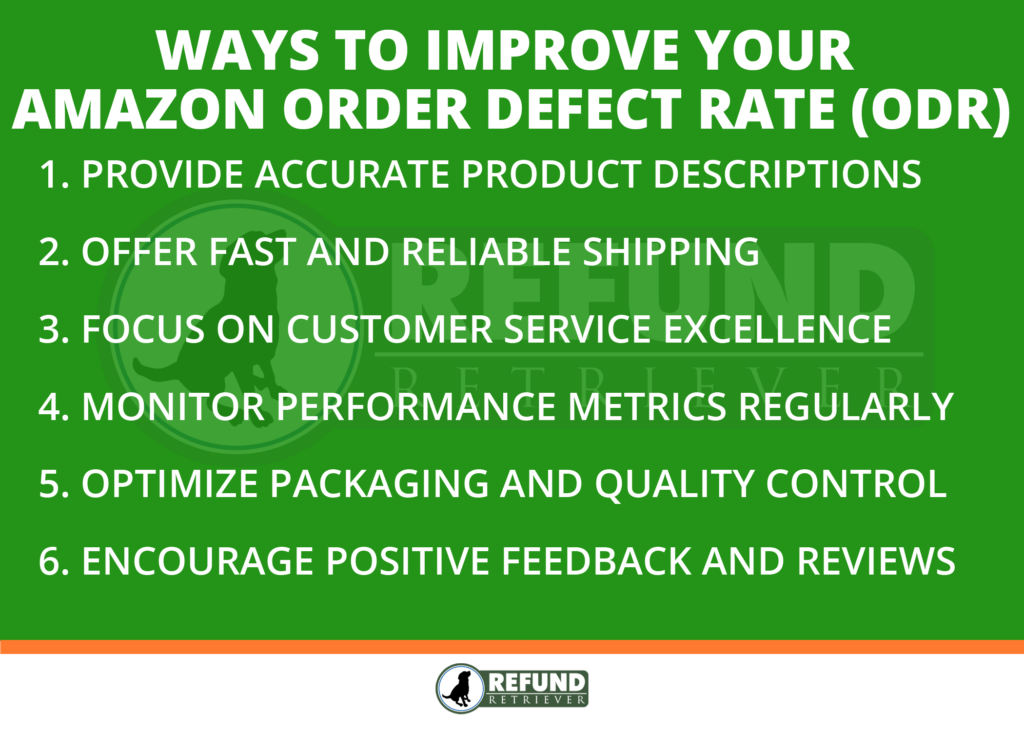The Amazon Order Defect Rate (ODR) is a key performance metric used to measure the health of a seller’s account. A high ODR can result in account suspension, while a low ODR can improve a seller’s chances of winning the Buy Box.
What is the Amazon Order Defect Rate (ODR)?
The Order Defect Rate (ODR) is a performance metric by Amazon to evaluate a seller’s ability to provide a positive buying experience. It measures the percentage of orders that have defects, including:
- Negative feedback: Unsatisfied customers who leave negative feedback on a seller’s product or service.
- A-to-Z Guarantee claims: Cases where customers file claims against sellers for issues like item not received or item not as described.
- Chargebacks: Instances where customers dispute charges with their payment providers.
Why is ODR Important?
Maintaining a low ODR is crucial for sellers on Amazon for several reasons:
- Account Health: Amazon uses ODR as a key factor in determining a seller’s account health. Sellers with high ODRs may face account restrictions or even suspension.
- Buyer Trust: A low ODR indicates to buyers that a seller is reliable and provides high-quality products and services. This can lead to increased sales and positive reviews.
- Competitive Advantage: Sellers with low ODRs may receive preferential treatment from Amazon, such as eligibility for promotions and the Buy Box.

Here are six effective ways to improve your Amazon Order Defect Rate (ODR):
- Provide Accurate Product Descriptions: Ensure that your product listings accurately represent the item being sold.
- Offer Fast and Reliable Shipping: Ship orders promptly and provide accurate delivery estimates to customers. Consider using Amazon’s Fulfilled by Amazon (FBA).
- Focus on Customer Service Excellence: Prioritize exceptional customer service by promptly responding to customer inquiries, concerns, and feedback. Be proactive.
- Monitor Performance Metrics Regularly: Stay vigilant by regularly monitoring your performance metrics, including feedback ratings, A-to-Z Guarantee claims, and chargeback rates.
- Optimize Packaging and Quality Control: Invest in robust packaging materials and practices to ensure that products arrive intact and undamaged. Proper packaging is essential.
- Encourage Positive Feedback and Reviews: Actively encourage satisfied customers to leave positive feedback and reviews for their purchases.
By implementing these strategies consistently, you can improve your Amazon Order Defect Rate (ODR) and build a reputation as a reliable and trustworthy seller on the platform. Remember that maintaining a low ODR not only enhances your seller metrics but also contributes to long-term success and growth on Amazon.
How to Manage Amazon ODR Effectively
- Understand the Components: ODR is calculated based on three factors:
- A-to-Z Guarantee claim rate: When a buyer feels that a seller has not met their expectations and is not addressing their concerns, they can file an A-to-Z Guarantee claim.
- Credit Card Chargeback Rate: When a buyer disputes a charge with their credit card company.
- Negative Feedback Rate: Based on negative feedback received in the past 90 days.
- Accurate Product Listings: Ensure that your product listings are accurate and provide clear photos.
- Quality Control: Always inspect products for defects or damage before shipping.
- Prompt Shipping: Always ship items promptly and use reliable carriers. Provide tracking numbers.
- Strong Communication Improves Amazon Order Defect Rate:
- Respond to buyer inquiries within 24 hours.
- Notify buyers of any potential shipping delays.
- Proactively address any issues or concerns a buyer might have.
- Pack Products Properly: Ensure secure packaging to avoid damage during transit.
- Feedback Management: Monitor and manage your feedback regularly.
- Address negative feedback promptly by reaching out to dissatisfied customers and resolving their concerns.
- Consider using automated feedback solicitation tools to encourage satisfied customers to leave positive reviews.
- Clear Return & Refund Policies: Make your return and refund policies fair. Process returns quickly.
- Manage Inventory: Regularly check and update your inventory levels to avoid overselling items.
- Train Your Team: Ensure your staff is well-trained in Amazon’s policies and best practices.
- Proactively Solve Issues: If you foresee an issue with an order (like a delay in shipment), proactively reach out to the buyer, inform them, and offer solutions like refunds or discounts.
- Stay Updated: Amazon’s policies and marketplace dynamics can change. Stay updated on any changes in the platform’s rules and adjust your practices accordingly.
- Analyze Metrics: Regularly review your Account Health Dashboard on Amazon Seller Central.
- Seek Feedback: Periodically request feedback from customers and work on improving areas.
What happens when your Amazon Order Defect Rate reaches above 1%?
- Account Review or Suspension: Amazon may place your account under review, and there’s a risk of suspension. If Amazon suspends your account, you won’t be able to sell on the platform until the issues are resolved.
- Loss of Buy Box: The Buy Box is the box on a product detail page where customers can begin the purchasing process. Sellers who have high-performance metrics are more likely to win the Buy Box. If your ODR is high, you might lose the Buy Box to competitors even if you have the lowest price.
- Reduced Account Privileges: Amazon might limit certain privileges or features for sellers with a high ODR.
- Loss of Prime Eligibility: If you’re using programs like Seller Fulfilled Prime, a high ODR might jeopardize your eligibility.
- Impact on Account Health: A high ODR is reflected in your account health dashboard. This is a centralized place where you can monitor your performance metrics. Poor account health can lead to decreased trust from potential buyers.
By focusing on providing exceptional customer service and maintaining high standards of quality, sellers can effectively manage their Order Defect Rate and build a successful business on Amazon.
In conclusion, Amazon’s Order Defect Rate is a critical metric that sellers should pay close attention to. By understanding its value and implementing strategies to manage it effectively, sellers can enhance their reputation, drive sales, and achieve long-term success on the platform.

